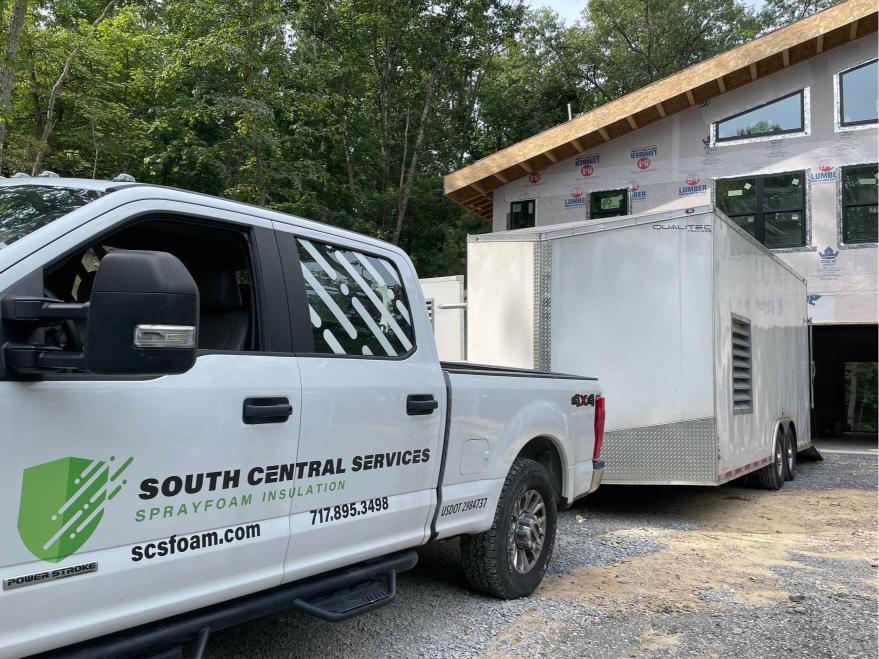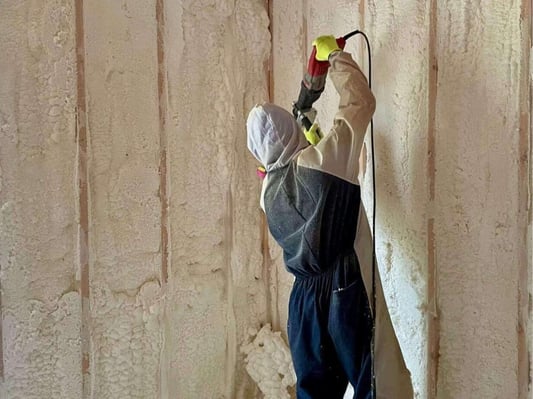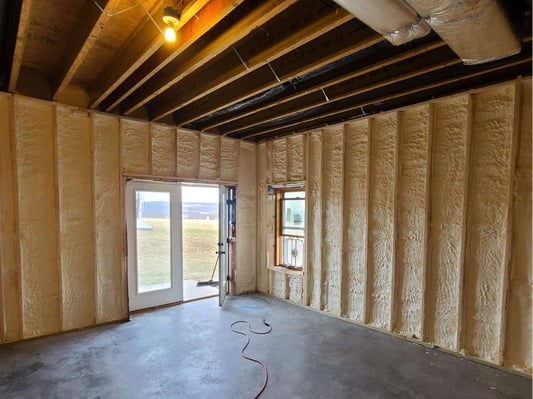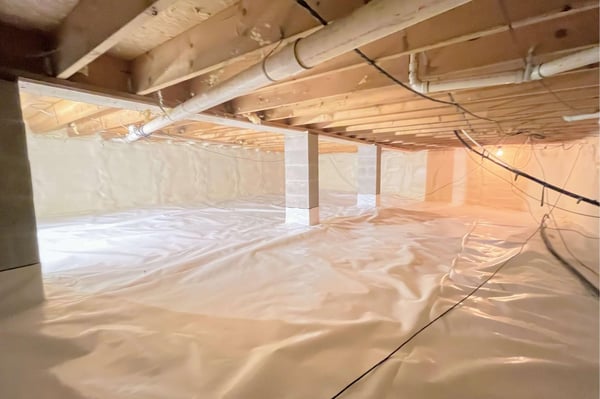
One of the best parts of building a new house is the opportunity to get everything right from the start. Anyone who has dealt with the quirks of an old home can appreciate the ability to prevent them. As your house is being built, you may be wondering about its insulation.
Which insulation should you choose? Does it matter where in your home is insulated? When should these insulation decisions be made?
South Central Services has insulated hundreds of homes with spray foam. There are six places where insulation should be installed in a new home. When it comes to new construction homes, we prefer to handle the whole insulation package so we can guarantee a good result for the homeowner.
By the end of this article, you will know:
- Where insulation should be installed in a new home
- What types of insulation are best for each area of the home
- Best practices when insulating a new home
Don't have time to read right now? Check out everything you need to know at a glance.
Where Should Insulation Be Installed In A New Home?
There are six places where insulation should be installed in a brand new home. Let’s examine them in more detail.
1. Exterior Walls
If we have learned anything from the high energy bills of historic homes, exterior wall insulation is vital. Exterior walls are a crucial part of the building envelope and are responsible for significant amounts of heat transfer.
This area of a home not only needs insulation but also needs a high-performing product.
Historic homes often need more exterior wall insulation. These older buildings have high energy bills because they lack effective wall insulation. If a new home chooses budget insulation for its outer walls, it will similarly experience high energy bills.
What Insulation Should I Use For My Exterior Walls?
We recommend three types of insulation for exterior walls in new construction homes: open cell spray foam, closed cell spray foam, and hybrid insulation.
Which insulation is best for you will depend on your climate zone, the material your exterior walls are constructed from, and your budget.
Generally, closed cell spray foam is the most expensive option. However, it offers both an airtight seal and a vapor barrier. Open cell spray foam is less costly, but cannot provide a vapor barrier.

For especially budget-conscious homeowners, consider a hybrid insulation method. Hybrid insulation combines the features of closed cell spray foam with the budget-friendliness of batt insulation. There are also other products that can be used for vapor barriers, if necessary for your climate zone.
2. Interior Walls
Interior walls are completely different from exterior walls. While exterior walls form a boundary between your home and the outside elements, interior walls are simply divisions between living spaces. As such, interior walls are most concerned with sound control.
Your interior walls are a place in your home where you can use more budget-friendly insulating materials. Since you do not need to create a thermal barrier between rooms, interior walls can be a place to save money in your new home.
What Insulation Should I Use For My Interior Walls?
South Central Services recommends batt insulation for interior walls. Batt insulation is a budget product that does not offer high insulating performance. Instead, batt insulation can be used to dampen sound transfer. However, other options exist besides fiberglass, cotton, and rockwool batts.
One insulation alternative for interior walls is dense pack cellulose insulation. By stapling netting to the wall studs, contractors create a cavity for cellulose to be packed densely inside the wall.

If you are especially concerned with sound transfer, consider soundproofing products for your interior walls. For most homeowners, batt insulation offers enough sound dampening. However, some homeowners may be more sensitive to sound and want to soundproof a room completely. If this description matches you, we recommend contacting our friends at Soundproof Cow for a consultation about interior wall products.
3. Attics
Attics are often overlooked in new construction. While attics need some insulation to meet code compliance, the insulation installed is rarely effective. Your attic is another critical area of your building envelope. Underinsulated attics transfer excessive amounts of heat between the home and the outside world.
Attics are usually insulated with budget products like batts or blown-in insulation. However, these products alone cannot provide the performance that an attic needs.
What Insulation Should I Use For My Attic?
South Central Services recommends open cell or closed cell spray foam for attics. To meet code compliance, you can either insulate the floor or the walls of your attic.
You can create a vented attic if you choose to insulate the floor. The airtight seal on the floor prevents air from exchanging between your living space and your attic.

If you choose to insulate the walls and gables of your attic, you can create an unvented attic. An unvented attic does not allow air to exchange uncontrollably between the inside and outside of the home. If you have HVAC ductwork in your attic, this type of insulation can reduce the heat load on the ductwork and make your HVAC system more efficient.
4. Basements
Basements are another area of your home that must be insulated to meet building codes. Like your exterior walls and attic, your basement is a part of your building envelope. The basement is below ground, which makes it a below-grade space.
Basements, being below the ground, can face excess moisture coming from the surrounding cool dirt. This humidity means basements should be insulated with a high-performing product and may also need a vapor barrier.
To meet building codes, either the basement walls or basement ceiling must be insulated.
What Insulation Should I Use For My Basement?
You can use faced fiberglass batt insulation in your basement walls. However, we do not recommend this product. While the facing of the batt insulation can provide some vapor retardation, there is no airtight seal with batt insulation. Cold air surrounding your basement walls can pass through batt insulation.
Instead, we recommend either open cell or closed cell spray foam.
Hoping to have a finished basement space? You'll need to insulate your basement walls. If you choose to insulate your basement walls, you'll need to use closed cell for its vapor barrier capabilities.

Don't care if your basement is used as living space? You can instead insulate the basement ceiling with open or closed cell spray foam. The most significant difference between these two types of foam in this application is the cost and sound attenuation capabilities. Closed cell is more expensive and offers less sound control than open cell.
5. Crawl Spaces
Crawl spaces do not have to be insulated to meet building codes, which is why most crawl spaces in Pennsylvania are both terrifying and smelly. If your new home has a crawl space, it is in your best interest to encapsulate that space.
Surprisingly, crawl spaces influence the energy efficiency and comfort of a house. If you don't want your new home to have cold floors or smell musty, your crawl space should be insulated.
What Insulation Should I Use For My Crawl Space?
Most "insulated" crawl spaces in southern PA have fiberglass batt insulation stuffed into the ceiling. The walls of the crawl space usually have ventilation holes, as well. This method is known as the ventilation method. The idea behind the ventilation method is that circulating air can dry out excess moisture in a crawl space.
When the ventilation method is implemented, it results in cold floors and musty smells. To combat the problems that a crawl space can cause, we recommend a technique called encapsulation.

Crawl space encapsulation includes closed cell spray foam and plastic sheathing. The goal is to create a seamless vapor barrier and add the crawl space into the home's conditioned space. If your new home has a crawl space, encapsulating it will protect your air quality and structural integrity from day one.
6. Underslab
Building a new home is the only time that your home foundation has the opportunity to be insulated. Once the house is constructed on the foundation, the underslab can never be insulated again.
Underslab insulation is not vital to a home. However, our team recommends underslab insulation when possible because of its benefits. Without insulation, your foundation can be cold and wet. The foundation can even face excessive radon levels without insulation.
What Insulation Should I Use For My Underslab?
Since your foundation is underground, your only available product is closed cell spray foam. As discussed earlier, closed cell spray foam creates an airtight seal and a vapor barrier. These two features will ensure your underslab stays dry and not excessively cold. A layer of closed cell spray foam on your foundation benefits your building envelope.

Best Practices For New Home Insulation
Now that you know the key areas of your new house that should be insulated, let's examine some best practices when insulating new homes.
Choose Your Insulation By The Time Your House Is Being Framed
We recommend picking your insulation out by the time your house is being framed. The framing of your home can influence how your home will be insulated and the details that need to be insulated.
For example, traditional framing methods create areas for air leakage. To combat this air leakage, we will insulate small areas of the home with caulking and can foam.
Insulate Places That Are Difficult To Access
Countless places in your home can only be accessed during construction. When you choose a contractor to insulate your home, ensure they understand the importance of insulating every nook and cranny.
Ensure Your Thermal Envelope Makes Sense For Your HVAC System
Insulation is essential to supporting your HVAC system. Without proper insulation, HVAC systems are left to deal with excess heat load, random temperature fluctuations, and humidity changes. The locations of your ductwork and HVAC systems will influence how you insulate your thermal envelope.
Wherever ductwork and machines exist in your new home, creating an airtight seal in the space around them supports their long term function.
The Bottom Line About How New Homes Should Be Insulated
New construction insulation presents many unique energy efficiency, comfort, and air quality advantages. Unlike existing homes, where insulation can be like a game of whack-a-mole, new homes can be insulated from top to bottom.
South Central Services recommends attic, basement, crawl space, exterior wall, and underslab insulation for maximum energy efficiency. Because these areas are related to the home's building envelope, it is best to use a premium product like spray foam to ensure high performance.
Interior walls should also be insulated for sound control. Interior walls are not part of the building envelope and aren't concerned with thermal transfer. You can use a more economic product like batt insulation or research soundproofing materials for interior walls.
Now that you know how new construction homes should be insulated, your next step is to:
- Compare two options for new construction exterior walls
- Weigh an argument for investing in pricier insulation for your home
- Discover what impacts the cost of new construction insulation packages
Disclaimer: While we strive to publish information accurate to building science, local building codes and standards supersede our recommendations.
Kilian has co-owned and operated South Central Services for 8 years. He is passionate about community involvement. In his spare time, he enjoys being with his family, playing ice hockey, and going fishing with friends.
Topics:


